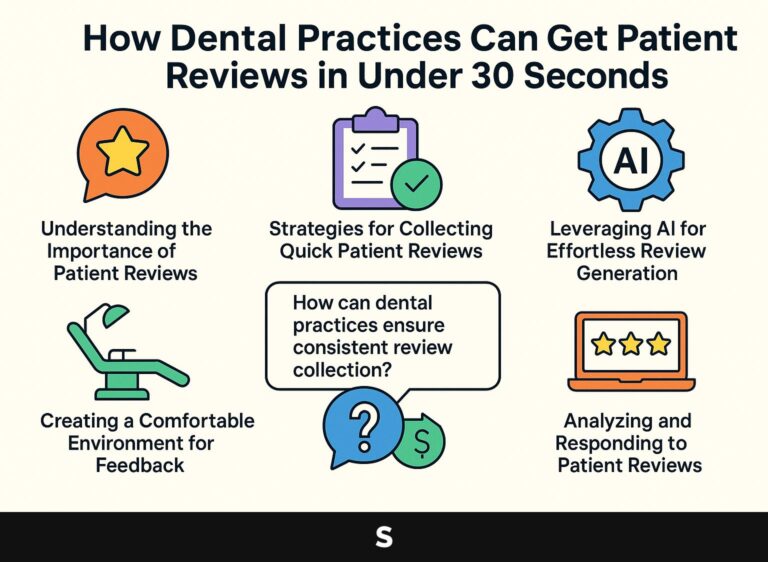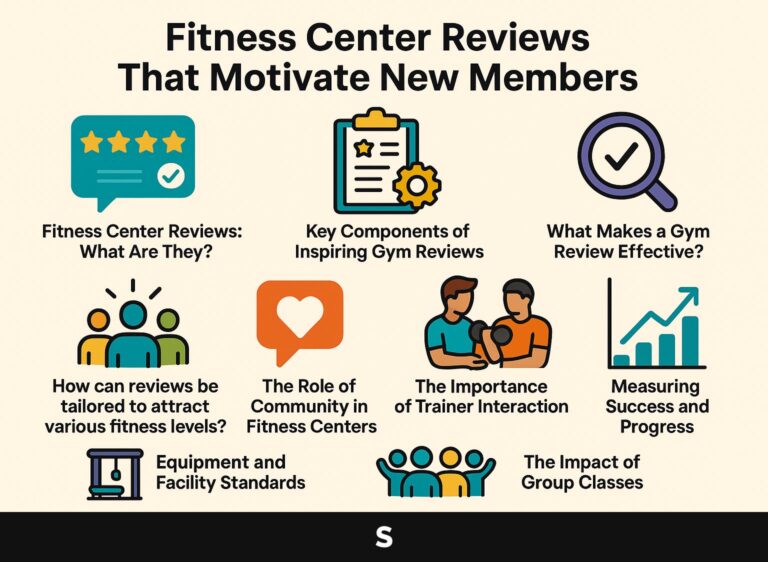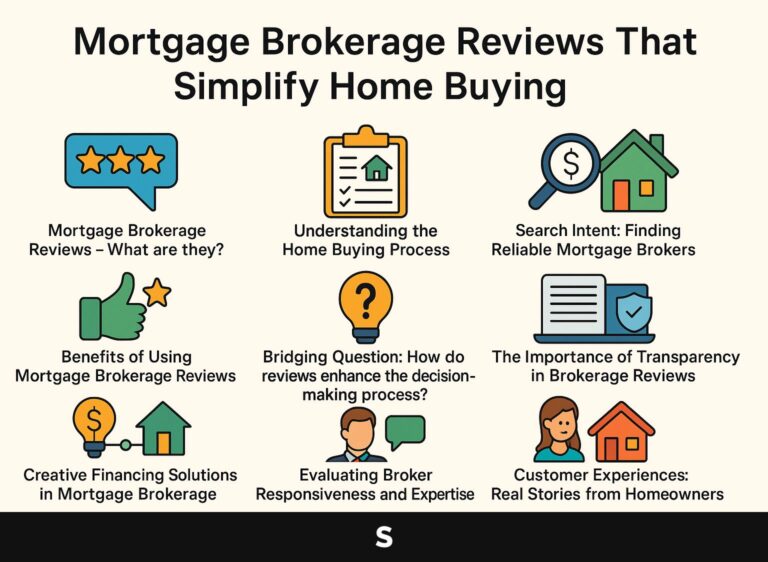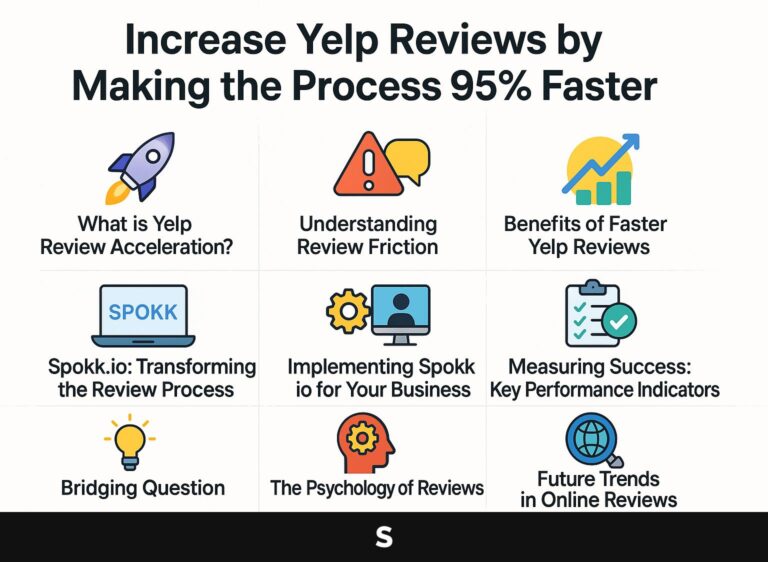Car Dealership Reviews That Build Trust and Drive Sales
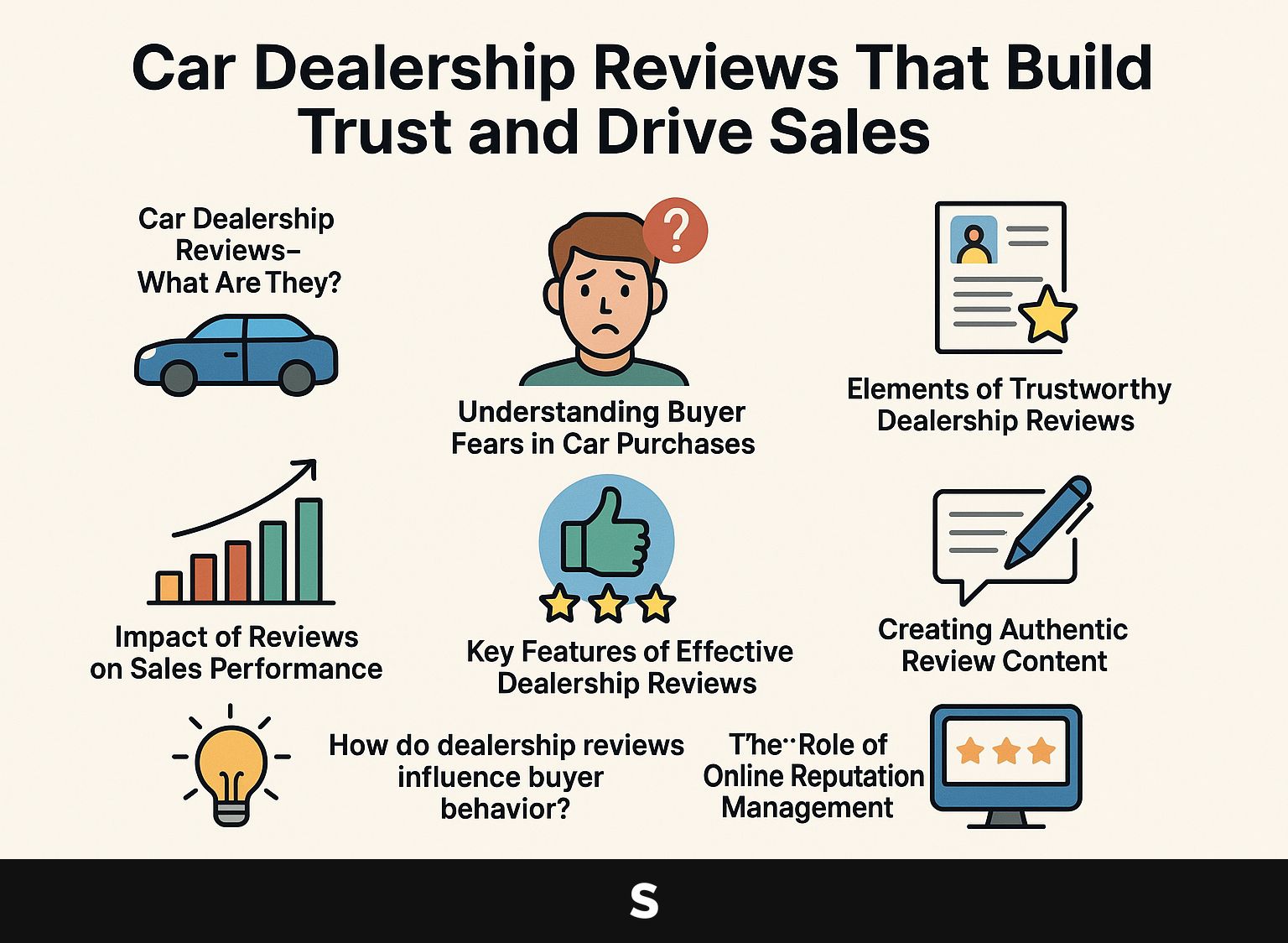
Buying a car can be intimidating, especially when worried about sales pressure and unexpected fees. At Spokk.io, we know that trust is essential when thinking about electric vehicles from respected companies like Ford.
Our findings show that honest dealership reviews help ease common buyer concerns, leading to better financial outcomes through clear pricing and dependable service. Learn how these reviews can improve your online sales and keep you updated on market trends.
Key Takeaways:
- Car dealership reviews are important for gaining trust and boosting sales during the car buying process.
- To effectively address common buyer fears, dealership reviews should include transparent pricing and financing options, and mention of excellent customer service.
- Dealerships can use positive reviews to increase sales and should focus on regular review management to keep customer trust steady over time.
- Car Dealership Reviews – What Are They?
- Recognizing Concerns of Car Buyers
- Elements of Trustworthy Dealership Reviews
- Impact of Reviews on Sales Performance
- Key Features of Effective Dealership Reviews
- Creating Authentic Review Content
- Using Reviews to Improve Marketing Plans
- How do dealership reviews influence buyer behavior?
- Knowing Why Online Reputation Management Matters
- Looking Ahead: Dealership Reviews
- Case Studies: Successful Dealerships and Their Review Strategies
- Frequently Asked Questions
- 1. What are car dealership reviews and why are they important?
- 2. How do car dealership reviews help to build trust?
- 3. Can car dealership reviews drive sales?
- 4. How can I use car dealership reviews to find the right dealership for me?
- 5. Are car dealership reviews on Spokk.io reliable?
- 6. Do car dealership reviews on Spokk.io only focus on positive experiences?
Car Dealership Reviews – What Are They?
Car dealership reviews are important stops in the buying process, giving information about dealership actions and customer experiences, especially in a business where trust is very important.
1. How do dealership reviews differ from other types of reviews?
Unlike standard product reviews, dealership reviews focus on complex transactions involving significant financial commitments and often include elements such as service quality and follow-up support.
To effectively evaluate a dealership, examine specific aspects such as pricing transparency, customer service experiences, and the thoroughness of their follow-up.
For example, check whether the dealership provides a full breakdown of costs, as this can prevent unexpected fees. Read customer testimonials to gauge responsiveness; dealerships with a high number of positive reviews about service quality typically prioritize customer care.
Do not overlook ratings on platforms like Google or Yelp, as they can reflect broader satisfaction levels regarding post-sale support.
2. What role do dealership reviews play in the car buying process?
Feedback from dealerships helps potential car buyers by sharing real experiences, making it easier to buy a car.
These reviews are important for helping you choose and checking if what dealerships say is true. For example, a prospective buyer often starts by reading aggregate ratings on platforms like Google Reviews or Yelp, focusing on specific feedback related to customer service and vehicle reliability.
When many reviews mention a dealership’s transparent pricing or great help after buying, customers feel more confident about their decision. Reviews focusing on specific models help buyers evaluate how satisfied they may be over time, steering them toward reliable cars and building trust in the buying process.
Recognizing Concerns of Car Buyers
It’s important for dealerships to know and address buyer worries to create a customer-friendly environment that encourages trust and satisfaction.
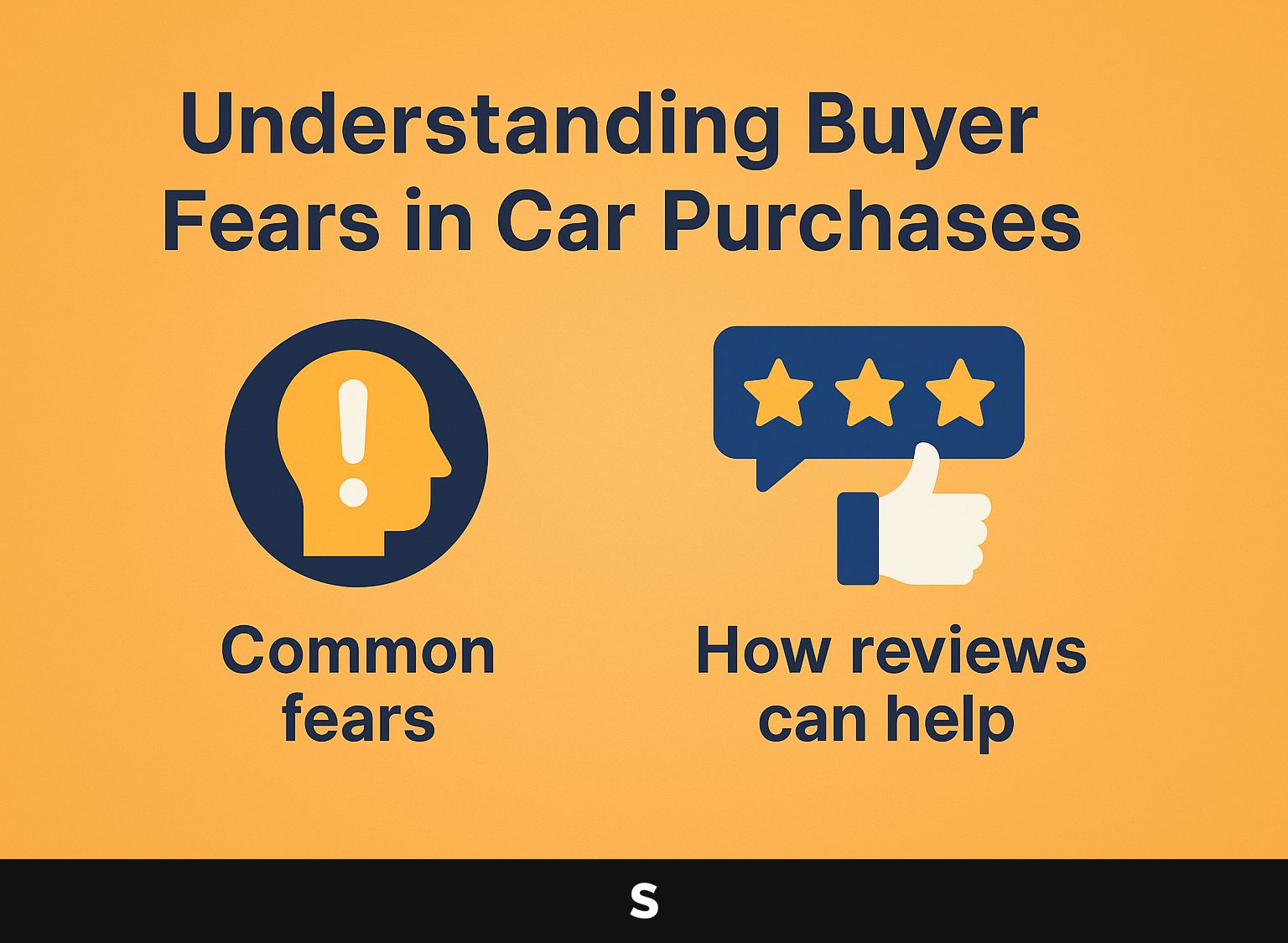
1. What are common fears buyers have when purchasing a car?
Buyers often face fears including high operational costs, hidden fees, and the risks associated with vehicle recalls, which can complicate their purchasing decisions.
High operational costs can manifest as concerns about maintenance and fuel efficiency. For instance, a buyer might hesitate over a high-performance SUV, fearing it will guzzle gas and lead to soaring expenses.
Hidden fees often arise during financing, such as unexpected dealer charges; thoroughly reviewing contracts can mitigate this worry. The anxiety around vehicle recalls can deter buyers from certain brands known for past issues.
Researching recall history and safety ratings on platforms like the National Highway Traffic Safety Administration (NHTSA) can help alleviate these fears.
2. How can reviews address these fears effectively?
Good dealership reviews can ease buyer concerns by showing clear pricing, good customer experiences, and strong after-sales support, building trust. To make the most of reviews, dealerships can gather feedback that directly talks about typical buyer worries.
For instance, feature a financing review from a customer who was initially hesitant due to high rates but ended up with a favorable loan.
Post comments focused on your customer service approach, highlighting instances where staff went above and beyond for timely responses.
Use social proof by showcasing these testimonials on your website and social media, ensuring they are easily accessible. This helps build trust and directly addresses buyer concerns.
Elements of Trustworthy Dealership Reviews
Reliable dealership reviews are genuine, provide detailed stories, and consistently have positive themes that connect with potential buyers.
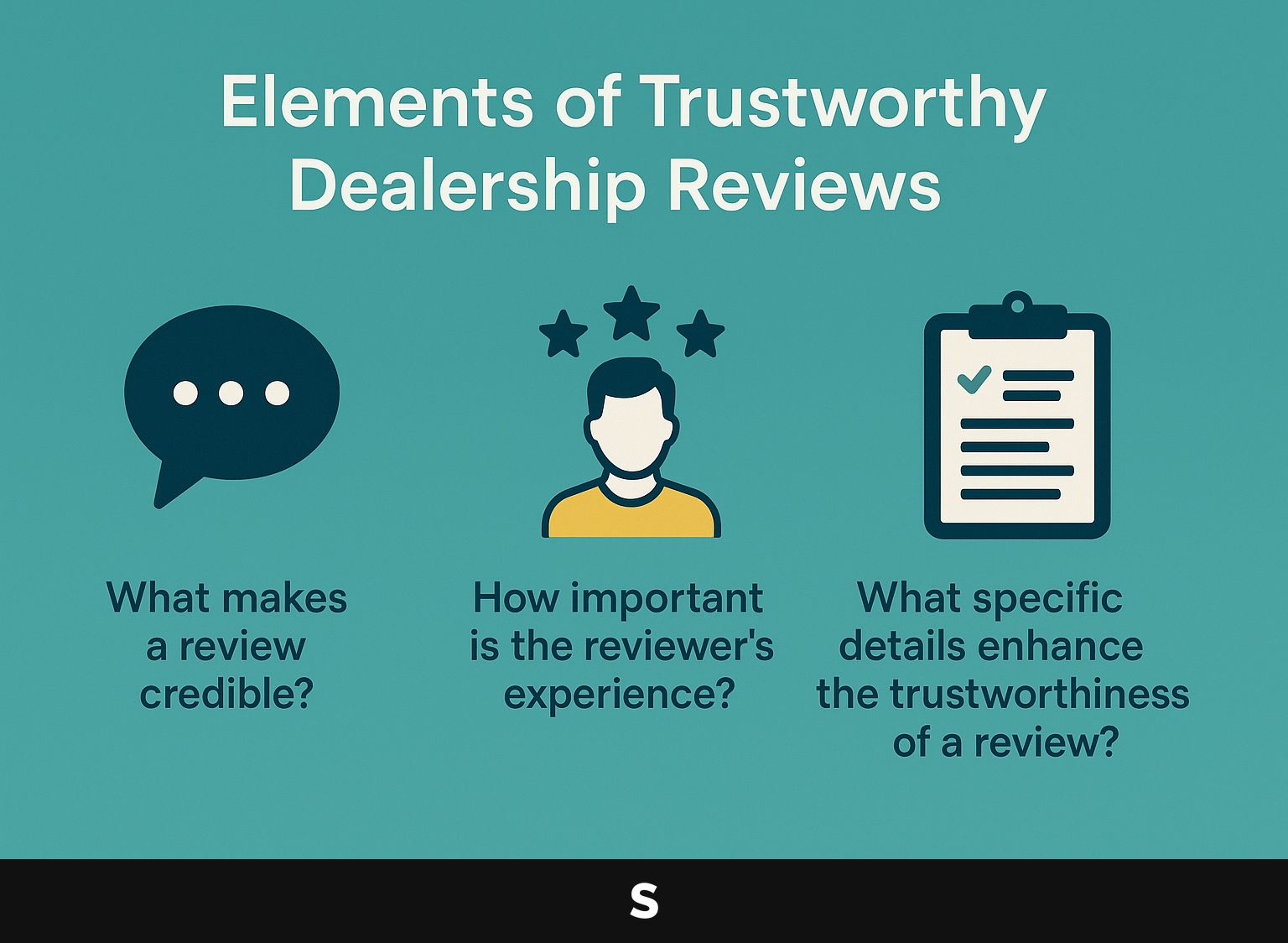
1. What makes a review credible?
A trustworthy review usually includes specific information about the purchase process, mentions real interactions with dealership employees, and shows a clear grasp of the deal.
Incorporating these elements builds trust with potential buyers. For instance, a review that explains how deals are made, including talking about prices and payment plans, provides useful information.
Mentioning specific car models, like the 2023 Honda Accord or the 2022 Toyota Camry, helps readers relate to their own experiences.
Describing the timeline of the purchase, from the first visit to receiving the keys, provides a complete story. Clear writing attracts readers and builds trust because it is honest.
2. How important is the reviewer’s experience in building trust?
The reviewer’s personal experience and background significantly influence the perceived trustworthiness of the review, as buyers often look for relatable contexts.
Someone buying for the first time might want clear information about product features and prices. They want confidence that their decision is right. Customers with experience often look for comparisons or performance information, valuing thorough user experiences.
For instance, if you’re reviewing a laptop, a novice might want specifics on battery life and ease of use, while an experienced user might prioritize graphics performance or upgrade potential. Adjusting your review to meet these specific needs makes it more relevant and trustworthy to your audience.
3. What specific details make a review more believable?
Including specific information like how financing is arranged, what happens during customer service calls, and how the dealership follows up makes a review more believable.
For instance, including exact financing terms can help potential buyers understand their budget. A review might mention, ‘The dealership offered a 3.9% APR on a 60-month loan for the Honda Civic, which was competitive compared to the 4.5% average.’
Sharing personal experiences, such as ‘The staff were responsive and followed up via email within a week,’ builds trust and informs readers.
Highlighting unique practices, like complimentary car washes or free inspections for the first year post-purchase, can set a dealership apart in reviews.
Impact of Reviews on Sales Performance
Positive dealership reviews can lead to higher sales and stronger customer loyalty.
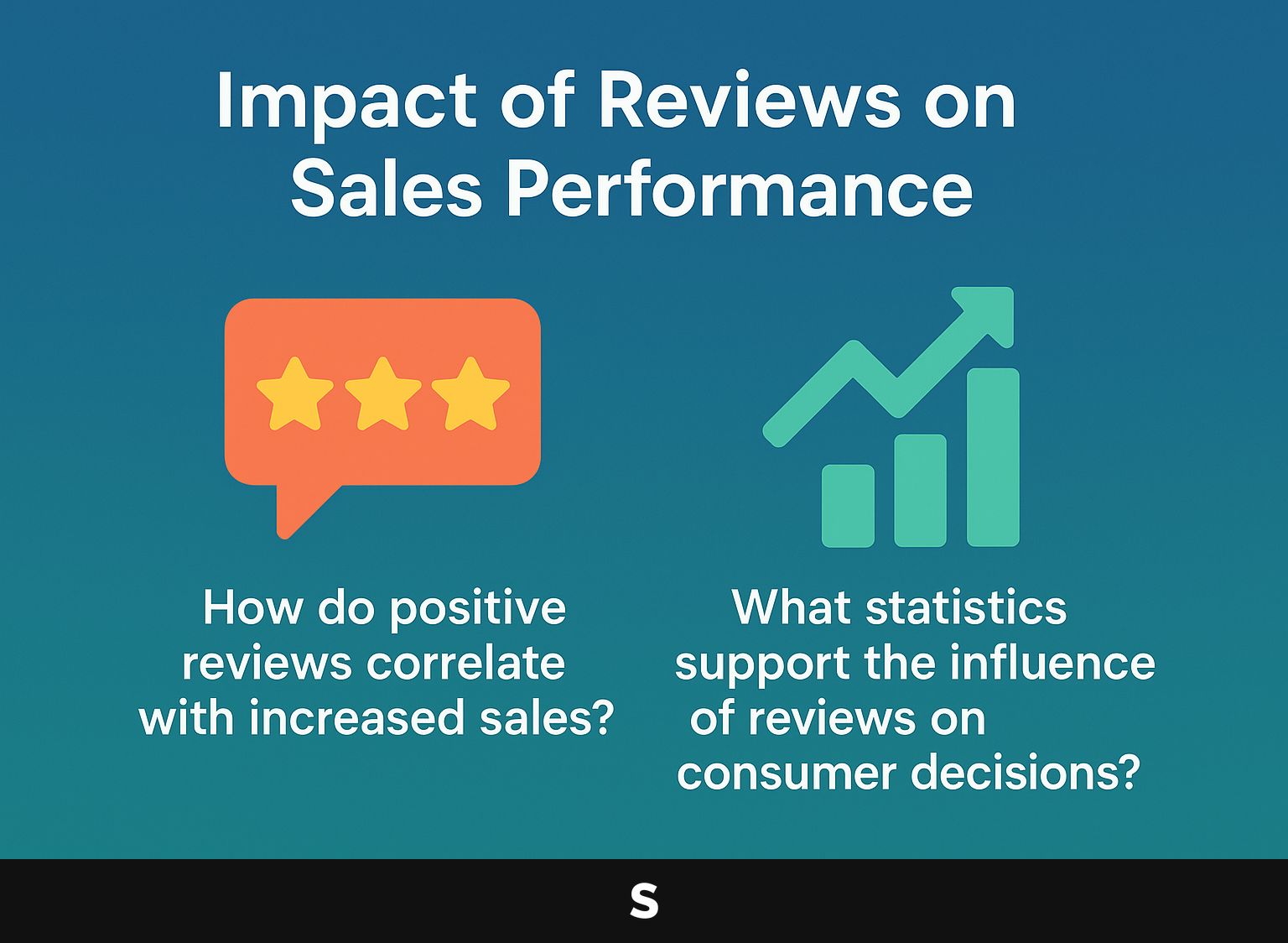
1. How do positive reviews correlate with increased sales?
Research shows that dealerships with higher ratings experience notable increases in sales, often by as much as 20% compared to those with lower scores on platforms like Google or Yelp.
To make this work for your dealership, concentrate on improving customer reviews. Ask for feedback after customers buy something; use tools like SurveyMonkey for sending out surveys automatically.
Reply quickly to all reviews, whether good or bad, to show reliability and good customer service. Show social proof on your website and marketing materials by displaying the best reviews clearly.
Using these strategies can improve your online reputation, draw in more customers, and increase sales.
2. What statistics support the influence of reviews on consumer decisions?
Studies reveal that 88% of consumers trust online reviews as much as personal recommendations, highlighting the critical role reviews play in shaping buyer decisions.
Most people, 79% of them, say they will look for a review before buying something, showing the impact of online opinions.
For instance, platforms like Yelp and Google Reviews significantly sway restaurant choices, while Amazon reviews can make or break a product’s success.
When happy customers share good reviews, businesses can improve their trustworthiness. Platforms such as Trustpilot and Birdeye gather reviews, offering a consistent flow of feedback that helps establish trust for upcoming customers.
Key Features of Effective Dealership Reviews
An effective dealership review includes important details that make it more useful and help gain trust with potential buyers.
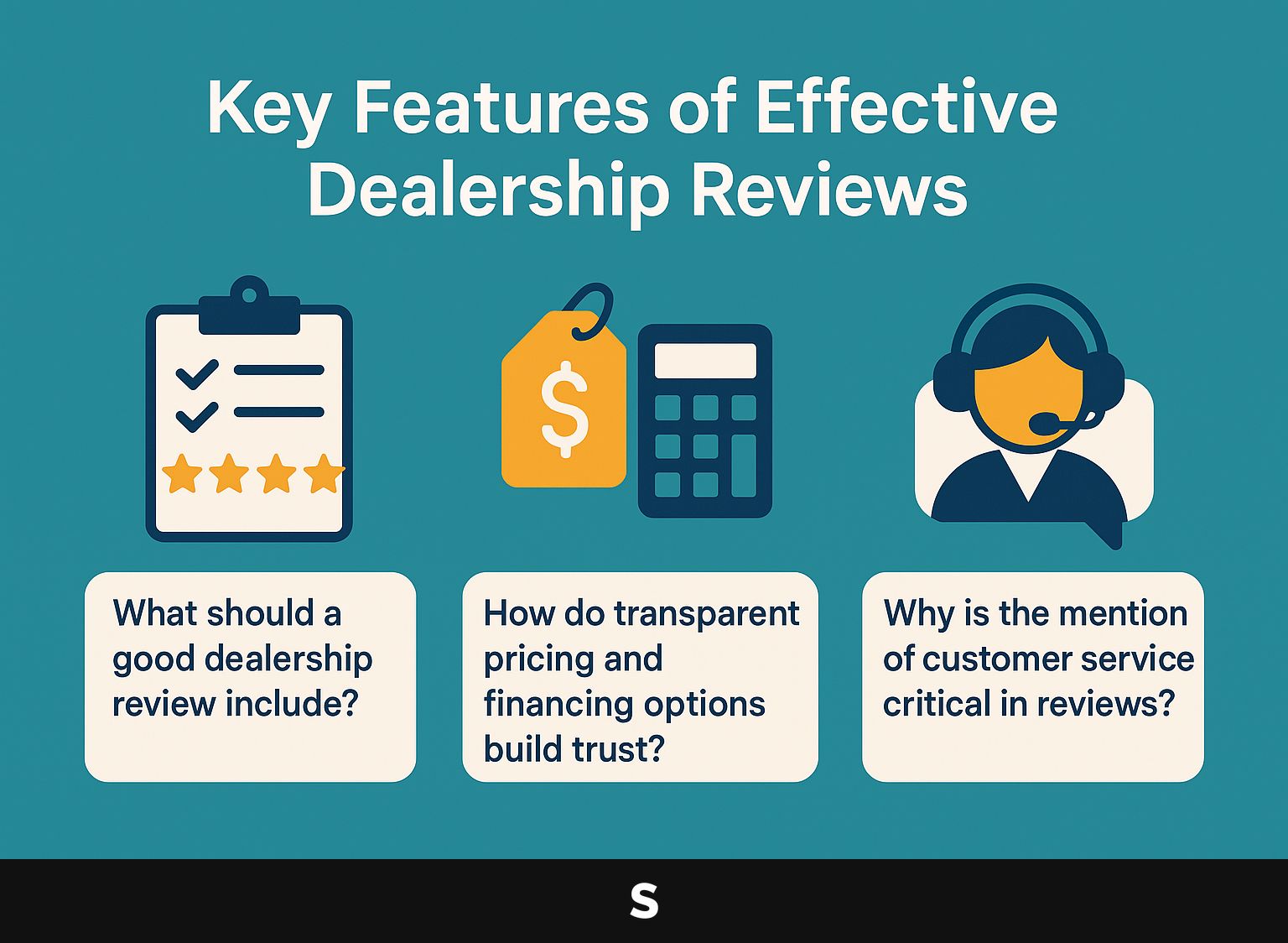
1. What should a good dealership review include?
A good dealership review should include specific information such as detailed pricing, descriptions of the sales process, and feedback on customer service interactions.
It’s important to talk about the choice of vehicle and its condition since these things often affect what buyers decide. Prospective reviewers should detail their experience with the negotiation process, highlighting whether the dealership offered fair pricing or pressured them into a sale.
Including comments about the service after purchase can make the review better. Real-life examples, such as how fast the dealership handled warranty problems or set up car maintenance, give potential buyers information that can influence their buying choices.
2. How do transparent pricing and financing options build trust?
Simple pricing and easy-to-understand payment options create trust by removing uncertainty and helping buyers feel sure about their choices.
To make things clearer, dealerships can add simple explanations to customer reviews. For instance, highlighting `All prices include taxes and fees’ or `Upfront financing options starting at 2.9% APR’ builds confidence.
Showing real examples from satisfied customers discussing their experiences with no hidden costs can further reinforce this message. Utilizing platforms like Google Reviews or DealerRater to collect and showcase these testimonials is effective.
Having a section on your dealership website that clearly shows pricing can greatly increase customer trust and satisfaction.
3. Why is the mention of customer service critical in reviews?
Customer service experiences detailed in reviews are critical indicators of a dealership’s reliability and can significantly affect consumer loyalty.
According to a J.D. Power survey, 60% of customers who rate their service as excellent are likely to come back for more purchases.
Reviews highlighting quick response times or hassle-free servicing encourage trust. Tools such as Google Reviews and Trustpilot can help dealerships monitor consumer feedback.
Setting up a system to quickly handle complaints improves service reputation and turns unhappy customers into supporters. For example, responding to a negative review with a sincere apology and a solution can lead to improved customer relationships and referrals.
Creating Authentic Review Content
Creating honest review content involves engaging customers and ensuring their feedback reflects their actual experiences. This is important for building trust.
1. How can dealerships encourage genuine customer feedback?
Dealerships can encourage genuine customer feedback by implementing strategies like follow-up surveys, loyalty programs, and incentivizing honest reviews through platforms like DealerRater and Yelp. To maximize feedback, consider setting follow-up surveys three days post-purchase to capture fresh impressions.
Use the customer’s name and mention their car in your messages. Create a loyalty program that offers special discounts for customers who give regular feedback, encouraging ongoing participation.
Ask for feedback right after service calls, giving direct links to review sites. These strategies increase the amount of feedback and make the responses more genuine.
2. What strategies can be employed to avoid fake reviews?
To tackle fake reviews, dealerships should use verification systems, check review platforms often, and motivate genuine customers to share their honest experiences.
One effective method is using tools like ReviewTrackers or Podium to monitor and respond to reviews across various platforms instantly. These tools allow dealerships to track mentions and verify the authenticity of feedback.
Car dealers can set up a system to contact buyers after a sale using services like SurveyMonkey, asking them to write detailed feedback. By giving minor discounts on upcoming services for genuine reviews, dealerships get more authentic feedback and create a trustworthy setting.
Using Reviews to Improve Marketing Plans
Using reviews effectively can improve marketing plans, attract customers, and make your business more noticeable online. For those looking to delve deeper into optimizing customer feedback, our comprehensive guide on customer feedback management offers valuable strategies.
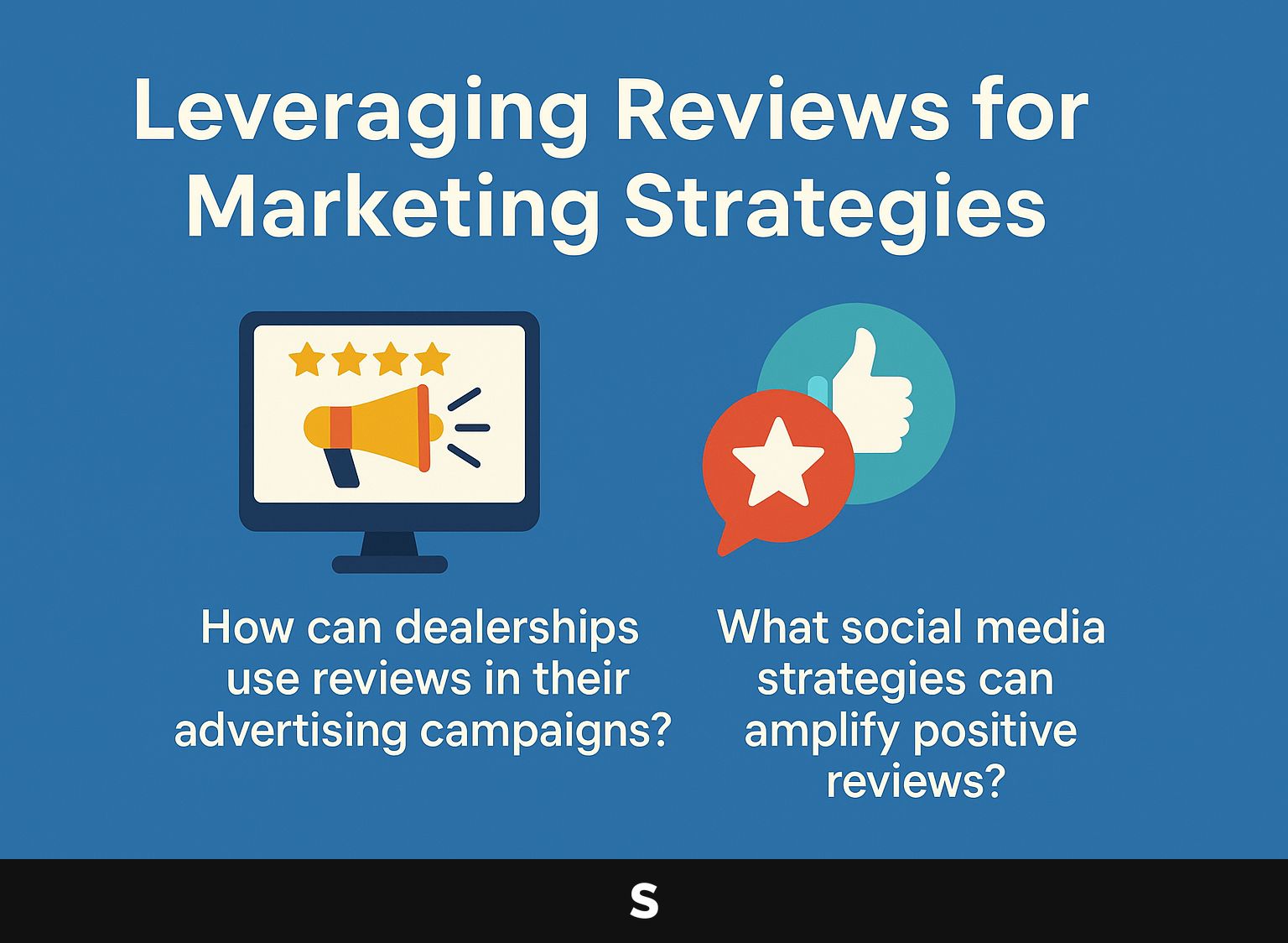
1. How can dealerships use reviews in their advertising campaigns?
Dealerships can use positive reviews in their advertising by including quotes and testimonials to show customer satisfaction and build trust.
One effective strategy is to create video testimonials featuring satisfied customers sharing their experiences. For example, a dealership could film a customer describing their seamless purchase process and outstanding service, then share this video on social media and local TV ads.
Using a platform like Yotpo can help aggregate reviews and display them prominently on your website and marketing materials. Creating ads that focus on a positive review, like pointing out a customer’s praise for a vehicle’s reliability, can connect well with potential buyers.
Utilizing social media platforms to share positive reviews can dramatically increase visibility and engage a wider audience, thus enhancing the dealership’s online reputation.
To maximize impact, focus on platforms like Facebook, Instagram, and Twitter. Create eye-catching posts by using visually appealing graphics or videos to highlight reviews, accompanied by hashtags such as #CustomerLove or #HappyCustomers.
For instance, a post could feature a customer’s testimonial overlaid on an image of their new car, shared with a caption inviting others to share their experiences.
Try posting reviews 2-3 times a week to keep your audience interested without giving them too much at once. This helps your brand remain memorable and gain trust.
How do dealership reviews influence buyer behavior?
Reviews of car dealerships play a big role in buyer choices because they affect how trustworthy and reliable a dealership seems, which can affect what people decide to buy.
Good reviews can make buyers feel more confident about buying something, as they often look for approval from what others have experienced. For instance, a dealership with a 4.5-star rating on platforms like Google or Yelp is often favored over one with 3 stars, even if both offer similar vehicles.
To improve your dealership’s reputation, ask happy customers to write reviews, and quickly respond to any negative feedback to show your dedication to keeping customers happy. This proactive engagement can significantly rebuild trust and attract more clients.
Knowing Why Online Reputation Management Matters
It’s important for dealerships to manage their online reputation. This means using strategies to maintain a positive public image and effectively address customer reviews. Those curious about enhancing this aspect might appreciate our guide on positive review examples for boosting customer satisfaction.
1. What is online reputation management, and why is it important for dealerships?
Online reputation management involves monitoring and influencing how a dealership is perceived across review platforms and social media, essential for attracting and retaining customers.
To improve how people view your dealership online, regularly check reviews on sites such as Google My Business, Yelp, and Facebook. Analyze customer feedback, noting recurring themes.
Next, adopt proactive engagement strategies: respond to reviews-both positive and negative-in a timely manner. Use tools like ReputationDefender or BirdEye to automatically check and reply.
Encourage satisfied customers to leave reviews by following up post-purchase. This approach increases your online visibility and builds trust and connection with potential buyers.
2. How can dealerships respond to negative reviews effectively?
It’s important for dealerships to handle negative reviews well, as this shows they care about keeping customers happy and can reduce harm to their reputation.
- Start by acknowledging the customer’s concerns with phrases like, “Thank you for your feedback; we take your experience seriously.”
- Next, offer accountability by stating, “We are sorry your visit did not meet your expectations.”
- Propose a resolution, such as, “We would love to address this issue directly-please contact us at [your contact info].”
- Follow up publicly, if possible, to show others that you value customer input and are committed to improvement. This method fixes relationships and improves how potential customers see you.
Looking Ahead: Dealership Reviews
Changes in the car selling industry are happening due to new market trends and technological progress, influencing what customers expect and how they act.
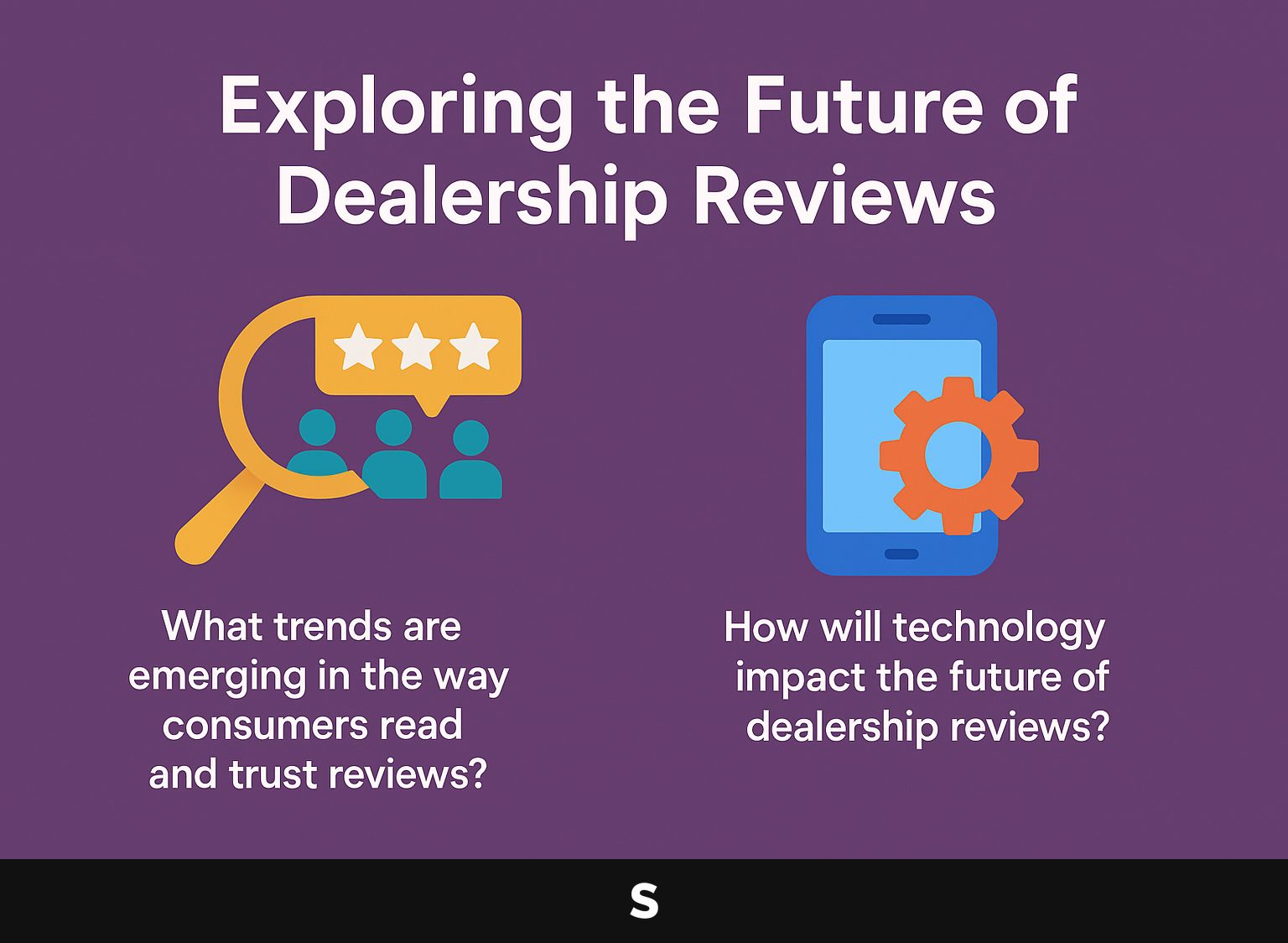
1. What trends are emerging in the way consumers read and trust reviews?
Recent trends show that consumers are more and more depending on detailed reviews, including video testimonials, to build their trust in dealerships. This shift towards visual content is driven by the effectiveness of seeing products in action before purchase.
Dealerships can use platforms like YouTube to post detailed review videos, showing car features and sharing positive customer stories. Integrating user-generated content, such as photo testimonials on social media, reinforces authenticity and relatability.
Platforms like Instagram and TikTok enable users to share brief reviews, which makes the content easy to reach and interesting. By combining video with social proof, dealerships can significantly influence consumer trust and drive sales.
2. How will technology change dealership reviews in the coming years?
Technology is set to change dealership reviews by using AI-based analysis, reputation management tools, and better user engagement features.
Platforms like ReviewTrackers use AI to analyze thousands of reviews, quickly finding the mood and important information. Tools like BirdEye allow dealerships to reply immediately to customer feedback, improving communication.
At the same time, new technologies like augmented reality can make the review process better by letting potential buyers see vehicle features while reading reviews. These improvements let dealerships collect feedback and connect with customers better, which can lead to more sales and loyal customers.
Case Studies: Successful Dealerships and Their Review Strategies
Studying successful dealerships that make good use of reviews offers helpful information on methods and strategies that build customer trust and loyalty.
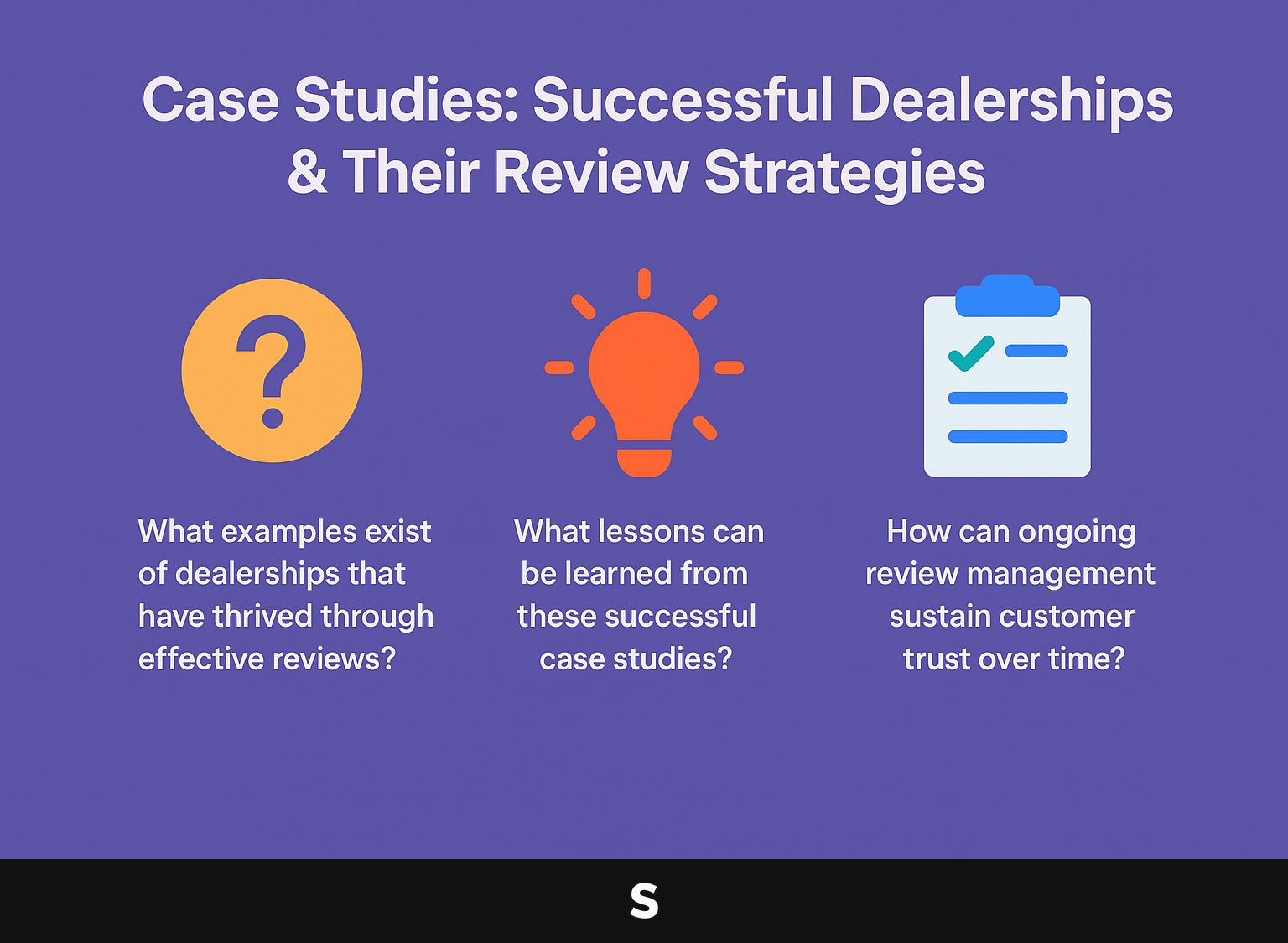
1. What examples exist of dealerships that have thrived through effective reviews?
Examples of dealerships like Ford and BMW highlight how effective review management can lead to increased customer satisfaction and sales growth.
For instance, Ford implemented a proactive review response strategy, using tools like BirdEye to monitor customer feedback. Online ratings went up by 20%, and showroom visits grew by 15% in six months.
BMW, on the other hand, used Reputology to examine feedback on various platforms, which helped them respond to complaints quickly.
As a result, they reported a 10% increase in customer loyalty and repeat purchases. These case studies demonstrate that investing in review management tools can yield substantial long-term benefits.
2. What lessons can be learned from these successful case studies?
Successful dealerships show that being active and honest is key to getting good reviews and keeping customer trust. To improve how reviews are handled, dealerships can use certain methods. Regularly responding to customer feedback-both positive and negative-demonstrates engagement.
For instance, a dealership might schedule weekly review check-ins using tools like Google Alerts or Yelp notifications. Implementing a follow-up email system after each service visit can also encourage satisfied customers to leave positive reviews.
Conducting training for employees every three months on handling feedback ensures communication remains clear and reliable, which improves customer relationships and trust.
3. How can ongoing review management sustain customer trust over time?
Regularly managing reviews by consistently interacting with customers and responding to their feedback is key to maintaining their trust in dealerships.
To effectively manage reviews, establish a routine of regularly monitoring platforms like Google Reviews and Yelp. Reply to each review, recognizing comments and dealing with issues quickly.
For example, create a template for thanking customers who leave positive reviews and develop a guideline for addressing negative comments constructively.
Use tools like Hootsuite or Reputation.com to manage notifications and respond to reviewers quickly. Set up a monthly meeting to go over feedback patterns and plan ways to make things better, creating a setting where ongoing improvements are encouraged.
Frequently Asked Questions
1. What are car dealership reviews and why are they important?
Car dealership reviews are feedback and evaluations from previous customers of a dealership. They are important because they help potential buyers understand the dealership’s reputation and customer experiences, allowing them to make informed decisions when buying a car.
2. How do car dealership reviews help to build trust?
Car dealership reviews provide honest opinions from past buyers, helping potential customers feel confident about the dealership. Positive reviews can build trust and confidence in the dealership, while negative reviews can highlight areas for improvement and show the dealership’s commitment to customer satisfaction.
3. Can car dealership reviews drive sales?
Yes, car dealership reviews can drive sales by showcasing the dealership’s credibility, transparency, and positive customer experiences. Potential buyers are more likely to trust and choose a dealership with a high number of positive reviews than one with no reviews or a high number of negative reviews.
4. How can I use car dealership reviews to find the right dealership for me?
You can use car dealership reviews to find the right dealership for you by reading through the experiences of previous customers. Look for reviews that mention factors that are important to you, such as fair pricing, transparent financing, and excellent customer service. This can help you narrow down your options and choose a dealership that aligns with your needs and preferences.
5. Are car dealership reviews on Spokk.io reliable?
Yes, car dealership reviews on Spokk.io are reliable. Spokk.io is a website that generates dealership reviews focused on typical concerns of buyers, offering a truthful and fair view of the dealership and its methods. These reviews are from real customers and can help you make an informed decision when searching for a car dealership.
6. Do car dealership reviews on Spokk.io only focus on positive experiences?
Reviews for car dealerships on Spokk.io cover both good and bad experiences. The platform highlights both positive and negative customer reviews to give a full view of the dealership. This shows the dealership’s commitment to customer satisfaction and its willingness to improve based on feedback.

